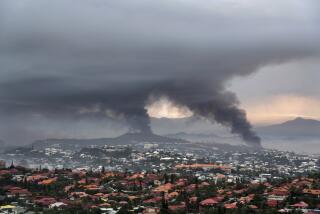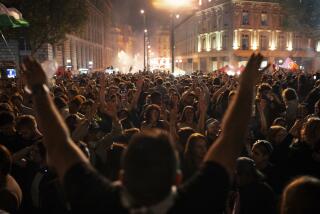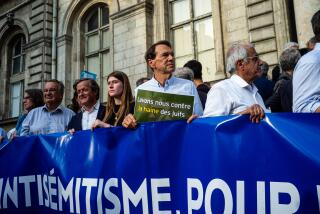Regional Outlook : Can Europeâs Right Wing Take Flight? : In Paris Suburb, Workers Shift Sharply Right
SEVRAN, France â Compared to other working-class suburbs in the Paris area, the city of Sevran is a surprisingly green and cheery place.
The grounds of a former gunpowder plant, once Sevranâs main industry, have been transformed into a handsome park. The town square features a circular flower garden. The sloping, grassy banks of the Our Canal, built by Napoleonâs Cossack prisoners of war, are tastefully landscaped.
On a recent morning, Mayor Bernard Vergnaud sat glumly in his small corner office at City Hall searching for the reason the town had turned against him and the Communist Party he represents. In regional elections held March 22, Sevran voters switched their longtime leftist allegiances to give a plurality to the extreme right-wing National Front Party led by Jean-Marie Le Pen.
Vergnaud, 61, a short, plump man, bald on top with a wild forest of red beard sprouting from his chin, appeared shocked.
Like an aging priest with a crisis of faith, the Communist mayor mechanically recited a catechism of accomplishments during his 15-year leadership in this town of 48,000 mostly working-class inhabitants. He mentioned sports fields and gyms, parks and playgrounds, cultural centers and day nurseries. There is a problem of petty crime, he admitted, but in the past five years he has increased the police force from 15 officers to 90.
âI just donât understand it,â said Vergnaud, looking lost and troubled. âWeâve tried to do everything for the people here. The town is clean. It has 34 square meters (366 sq. ft.) of green space for every inhabitant, more than any other town in the region. We were green even before it became politically fashionable.â
Like other former Communist strongholds in the northern industrial suburbs, Sevran, located about 10 miles northeast of Paris near Charles de Gaulle International Airport, is undergoing a radical political metamorphosis.
Changing immigration patterns, unemployment, increased crime and the collapse of international communism--all integral parts of the Le Pen message--have created a receptive audience for the National Front leader in the former âred beltâ surrounding Paris. Increasingly, the bastion of communism is becoming Le Pen country. In all, seven cities with populations over 40,000 in the Seine-St. Denis and neighboring Val DâOise regions gave the National Front a plurality in the regional elections.
Sixty years ago, when it began receiving the first waves of Italian, Polish and Armenian immigrants, Sevran was a quiet farming town of 3,000 people.
âI remember when we used to buy our milk directly from the farm,â recalled Elisa Vahardian.
Vahardian, 58, was born in Sevran, daughter of Armenian immigrants. Today, she directs the city cultural center, attempting to answer the needs of a widening ethnic array of Third World immigrants. The latest arrivals are from Pakistan, Turkey, Laos, Cambodia and Mali.
The new immigrants are darker in skin color and younger than their predecessors. They are predominantly Muslim although the Asian influx has also brought many Buddhists.
âIntegration was easier before when the immigrants tended to be all white and Christian,â said Vahardian. âThe longtime residents here have a hard time accepting people of color. They have the feeling they have been invaded.â
Traditionally, the Communist Party was the bridge that helped integrate the immigrant workers into French society.
Viewing the immigrant workers as potential vote banks, the Communist leadership in the industrial suburbs pushed for the huge public housing projects called Habitation Loyer Modere--low-rent housing. After spending one generation in the projects, the immigrants generally moved out to private residences in the same towns.
But with the collapse of communism worldwide, the French party no longer plays the critical role of integrator. Fewer and fewer workers identify themselves with the Communists. National party electoral support has fallen from over 20% 15 years ago to less than 8% today. A poll conducted by the newspaper Liberation in Paris showed that more voters who identified themselves as workers cast their ballots for the National Front (19%) than for the Communist Party (11%).
Meanwhile, the giant workersâ public housing projects have become, like the housing projects in American inner cities, shelter for the poor and unemployed.
Rather than a boon to the community, the housing projects are viewed as a source of problems and a breeding ground for crime. Owners of private homes look with envy toward other communities that did not allow housing projects inside their boundaries. White private homeowners, middle-class apartment dwellers and storekeepers vote increasingly for the National Front.
In Sevran, which has 6,662 housing units in the HLM complexes, and other troubled northern industrial suburbs such as Argenteuil and St. Denis, the story is the same. Increasingly, the townspeople are fearful and divided. The towns are split between the project dwellers and those who live outside.
âWhat we have here today,â said Alain Jolivet, a National Front activist and a member of the Sevran City Council, âis a situation the same as the one in Lebanon before the civil war.â
On the same day that the mayor was stewing over his declining political fortunes, Jolivet, 38, a stern, rail-thin postal worker, and Seine-St. Denis regional National Front leader Roger Holeindre lunched in the run-down cafe near the main rail station of Sevran.
Having won the regional election, the two men and a handful of local volunteers were plotting their strategy for the second round of local cantonal elections in the area. Holeindre, 63, a former journalist and author of right-wing books, had just written a new election pamphlet that included a hand-written note to voters.
âIt would be more than fitting,â the note said, âif Sevran could be the site of the final blow against the red belt of communism . . . â The pamphlet pounded on the usual National Front themes:
* âPriority in hiring to French (no matter what their race or religion but FRENCH).â
* âStrict control of the borders. . . . â
* âRepatriation of non-working foreigners and illegal aliens. . . . â
* âImmediate end to the granting of French citizenship to foreigners born in France.â
Smoking a cigar and analyzing his election victory in Sevran, Holeindre said it broke down into several factors.
âThe people here have a real fear of crime,â he said. âThey feel there has been a veritable invasion of foreigners who have nothing to do with former French colonies--Iâm talking about Pakistanis, Sri Lankans and Tamils. Finally, I think there are many patriots who hate the Communists who rule here. They know the Communists are the ones who let the foreigners come here in preference to the French.â
To get a good picture of the atmosphere of fear and crime that exists in the city, Jolivet suggested a reporter visit one of the townâs biggest housing projects, called Rougement. âItâs about 10% French white people,â Jolivet said. âThe rest are mostly from North Africa.â
Rougement, a complex of public housing buildings constructed in the late 1960s, is located on the outer edge of Sevran, far away from the modest private homes along the canal and near the old city center where the National Front made its strongest showing. The streets of the complex are named for French poets and writers. But the basketball gym is named for Jesse Owens, the American Olympic athlete.
Compared to most American projects, Rougement looked fairly well-maintained. No broken glass was in sight, no garbage and no barred windows or bulletproof glass in the stores. There was no feeling either of menace or danger and no sign that any of the residents felt threatened.
For the past 10 months, the grocery store has been operated by a Laotian family. The changeover from Arab ownership included an addition of products like dried, shredded pork skin catering to Asian customers.
But Lammanivone Kheive, 46, selling vegetables in the stall outside the store, said business has been tough. âThe only way we can make it is if the whole family works all the time,â Kheive said, shivering in his U.S. Air Force flight jacket.
Down the row of small stores, in front of a coin-operated laundry, three young French Arabs, children of Moroccan immigrants readily expressed their opinions about the town vote for the National Front.
âWhy did the people vote for Le Pen?â said Farid Kadri, 19, repeating the reporterâs question. âSimple, because they are all jerks. Thereâs a lot of racists in France who donât like blacks and Arabs.â
âItâs the same everywhere,â said Mohammad Boujema, 19. âItâs just like the racism in the United States against the blacks.â Boujema, an unemployed plumberâs assistant, said he âforgot to voteâ but regretted it when he heard about the National Front victory in the town.
Older and perhaps more thoughtful, Ahmed Douhi, 22, an accounting student, said he cast his vote in the regional elections for the French Greens, one of two national environmental parties. In the more local cantonal elections, he said he voted for the Communists to block Le Pen.
âI have this feeling,â he said, âthat if Le Pen ever got to power he would be a dictator, like another Hitler.â
More to Read
Sign up for Essential California
The most important California stories and recommendations in your inbox every morning.
You may occasionally receive promotional content from the Los Angeles Times.










